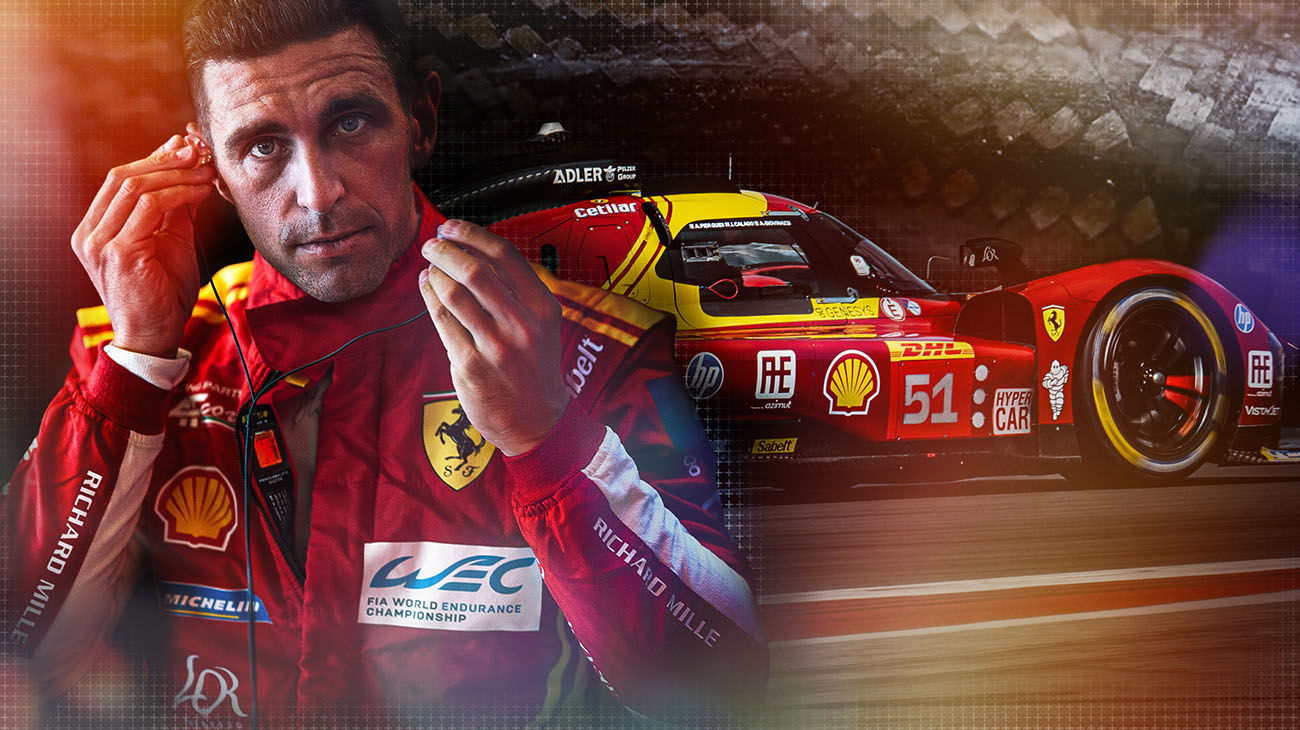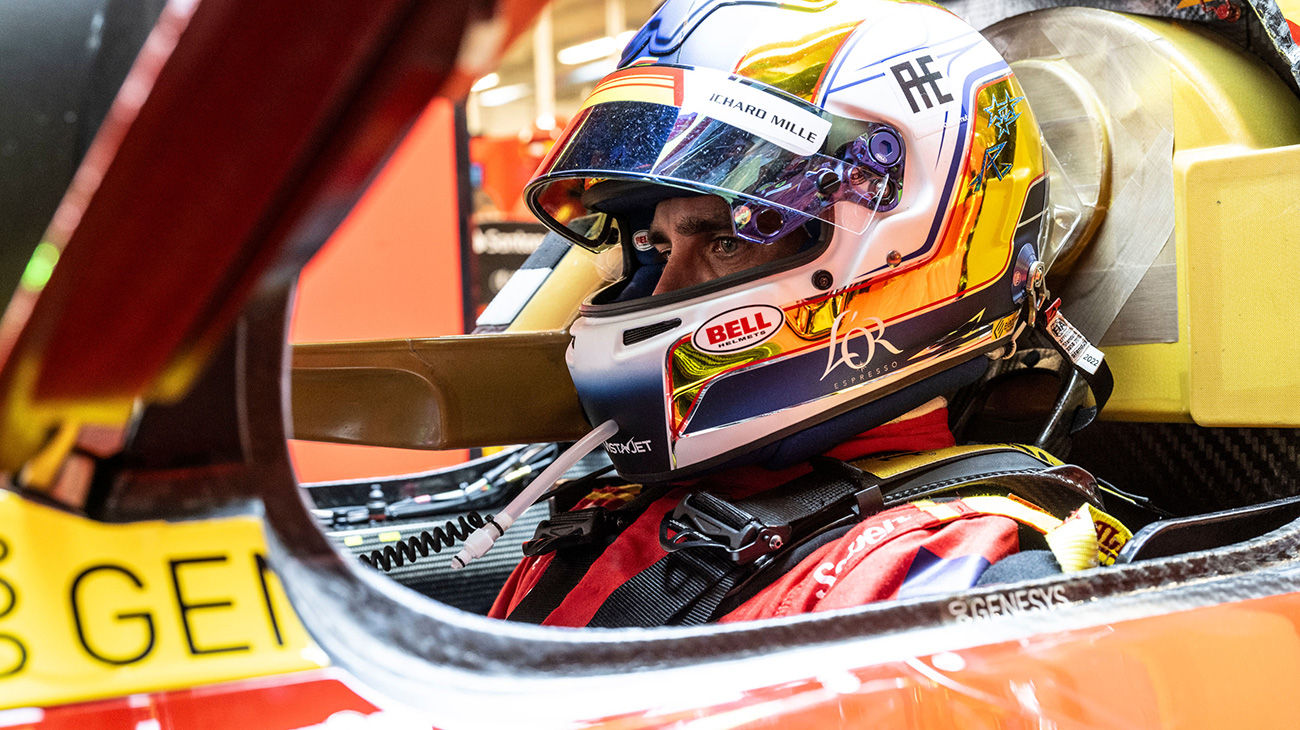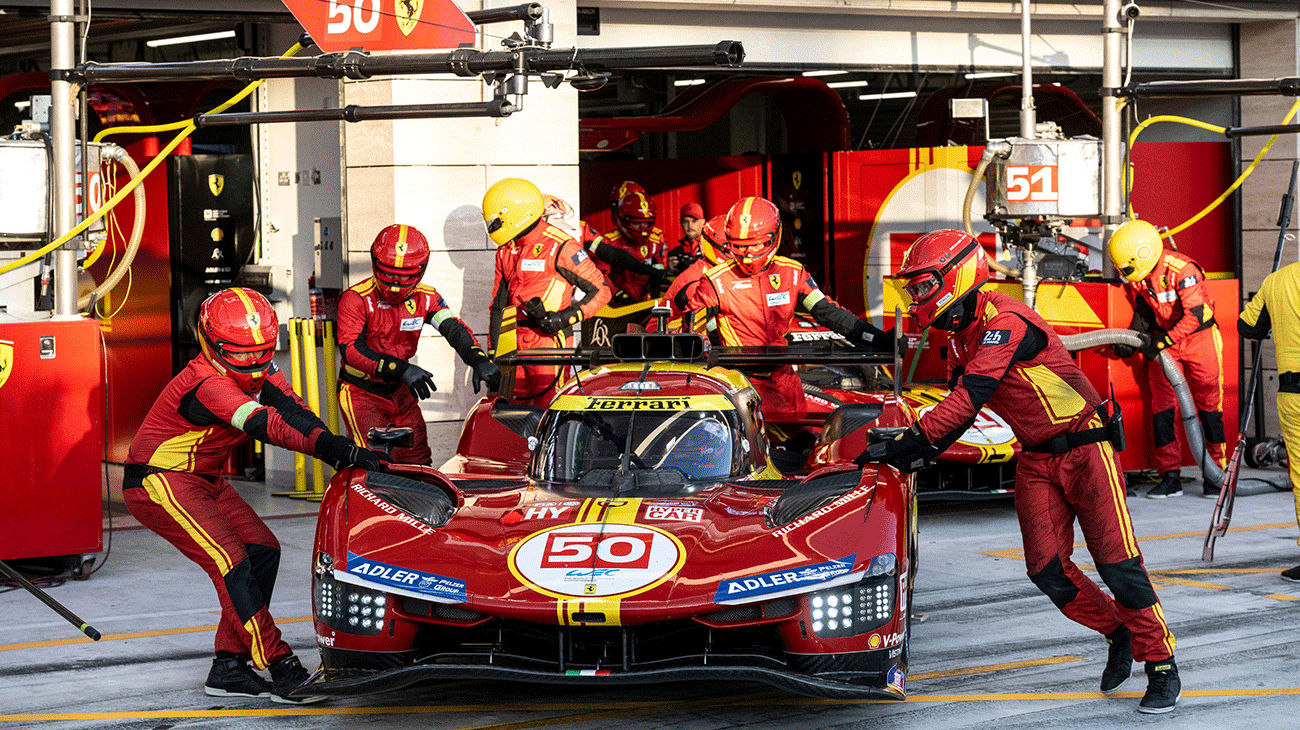
Ferrari 499P
A car already part of motorsport history

The 499P features a hybrid powertrain that combines an internal combustion unit – a mid-rear V6 engine – with an electric unit on the front axle.
The internal combustion engine (ICE) has a maximum regulation-limited output to the wheels of 500 kW (680 cv) and is derived from the road-going twin-turbo V6 family.
The ICE, which shares the architecture of the engine fitted to the 296 GT3, has undergone a thorough overhaul by Ferrari’s engineers, aimed both at developing ad hoc solutions for the prototype and lightening the overall weight. Among the specific characteristics of the 499P's V6 is the fact that the engine is load-bearing and therefore performs a valuable structural function, compared to the versions fitted to competition GT cars, where the engine is mounted onto the car’s rear sub-chassis.

The second ‘soul’ of the hybrid powertrain is the ERS - Energy Recovery System - with a maximum power output of 200 kW (272 cv).
The electric motor is equipped with a differential and is driven by a battery that is recharged during deceleration and braking, requiring no external power source. The battery pack, with a nominal voltage of 800v, benefits from experience honed in Formula 1, although it was purpose-built for the project.
The 499P’s overall maximum power output is 500 kW (680 cv) and the powertrain is coupled to a seven-speed sequential gearbox.

- V6 ICEENGINE
- 500 kwPOWER
- 800 vBATTERY
- 4WDTRACTION
WIND DESIGN




After claiming a second consecutive victory at the 24 Hours of Le Mans with a car that was technically unchanged from the previous season, the 499P benefited from its first development package, primarily aimed at improving the efficiency and effectiveness of rear brake temperature management.
The designers focused on internal fluid dynamics, but two flicks were introduced at the ends of the nose to comply with technical regulations. These aerodynamic appendages help rebalance airflow, improving the car’s overall balance.
However, despite their generous size, they have a negligible effect on pure lap-time performance.

The 499P features sophisticated aerodynamics in both its bodywork and internal fluid dynamics.
Large vents behind the front tyres are seamlessly integrated into the 499P’s overall design to optimise the management of hot air flows generated by the braking system.
From theoretical studies and virtual simulations to wind tunnel testing – and further refined by development on the Maranello simulator and track trials – the journey to perfecting the 499P’s aerodynamics was a complex team effort. The process involved calculation, wind tunnel, full-scale, and on-track tests, spanning more than 22 months and over 3,000 hours of testing.

The regulations permit the use of an Adjustable Aerodynamic Device, which has been incorporated into the rear wing of the 499P. This component is adjusted to modify downforce and redistribute aerodynamic load between the front and rear while adhering to strict technical regulations.
Ferrari engineers can fine-tune this feature using invaluable driver feedback and telemetry data to optimise the car’s aerodynamic performance. By effectively managing airflow, it generates forces that boost grip, allowing the car to corner at higher speeds without negatively affecting drag.

EVERYTHING UNDER CONTROL




The left side of the 499P’s steering wheel features tactile controls that drivers frequently use in the course of a race weekend. The most well-known buttons include:
“RA”, pressed by the driver to communicate with the race engineer.
“FCY”, activating Full Course Yellow mode, limiting the car to the maximum allowed speed during a controlled neutralisation. A crown surrounds this button to prevent accidental activation.
“SCR”, to scroll through various available display screens
“FLA”, to activate high beam flashing to signal the 499P’s approach to slower vehicles
“WIPER”, to activate windscreen wipers in the rain
“NEUTRAL”, to put the car in neutral during pit operations

As with every self-respecting Ferrari, the Prancing Horse logo is displayed at the centre of the 499P’s steering wheel. Despite being a multifunctional manettino – one of four on this section of the wheel – the logo always remains in its original position.
Drivers must be able to monitor the most crucial data and communications at all times – whether day or night, at extreme speeds, while cornering, or amidst considerable cockpit vibrations. This is why they played a key role in deciding the information displayed on the central screen. Tyre pressures and temperatures, the battery’s SoC (State of Charge) level, brake temperatures, and gear position and engine rpm are among the most critical data points. The driver can continuously monitor the predicted lap time and the delta to their personal best lap. The traction control settings and remaining energy level are also always available to the driver.

Racing enthusiasts are most familiar with the 499P steering wheel buttons related to re-entering and restarting from the pit lane.
“PIT”, to limit the speed to 60 km/h in the pit lane
“OK”, allows the driver to confirm an option offered in the menu
“DRI”, short for “drink”, is the button the driver presses to activate the pump delivering water to the helmet
“MARKER”, enables the driver to “mark” a specific moment during a lap to analyse the car’s behaviour with engineers after the session
“FUEL” resets consumption data after refuelling


2025 LIVERY

Set to make its race debut in Qatar on 28 February, the 499P thus pays homage to Ferrari’s recent history while still celebrating its predecessor, the 312 PB. This was Maranello’s last Sport Prototype, which competed until 1973 before a 50-year hiatus that ended in 2023 with Ferrari’s return to the top class of endurance racing. True to the philosophy of the Prancing Horse, the 2025 499P looks ahead, supported by the creativity of Ferrari’s designers.
The livery has been modernised with a new composition, blending red – a darker shade that reinterprets the colours seen on Ferrari race cars from past decades – with Giallo Modena, accentuating the car’s body lines. The 499P’s livery features a dominant glossy red finish, optimised for high car visibility, particularly in nighttime racing. This is complemented by matte accents that align with Scuderia Ferrari HP’s Formula 1 single-seater design.

The cockpit retains the signature yellow diagonal stripe – a hallmark of the 499P since 2023 – but unlike last season, this graphic now extends across the side pods instead of the lower section of the side.
This design choice accentuates the side pods longitudinally, further enhancing the car’s dynamic presence. The effect is particularly striking when viewing the 499P from above – such as from the grandstands – offering fans an original and innovative visual experience.

DRIVERS

The Ferrari 499P is a manifesto to our commitment to endurance racing.
The four-wheel drive prototype complies with the technical regulations and requirements of the hybrid-engined Le Mans Hypercar class, delivering a maximum power of 500 kW to the wheels and with a minimum weight of no less than 1,030 kilos.
In defining the 499P, the company has drawn on the vast resources of technical, professional and human excellence that epitomise the Maranello marque, entrusting the management to Attività Sportive GT, under the direction of Antonello Coletta and the technical supervision of Ferdinando Cannizzo, head of the department in charge of engineering and development of Sports and GT racing cars.











